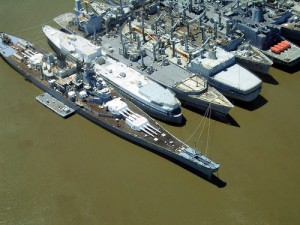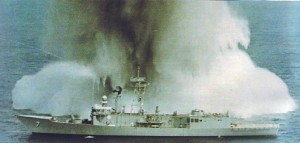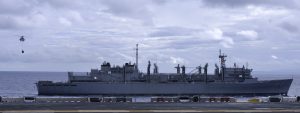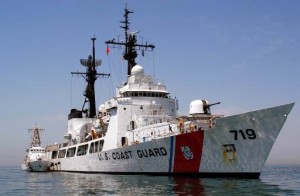 In the race to a 350-ship Navy, all eyes are on the mothball fleet.
In the race to a 350-ship Navy, all eyes are on the mothball fleet.
According to the CNO, at a War College speech, reactivation proposals are being mulled for about eight of the twenty-two Oliver Hazard Perry Class Frigates in layup. I’d assume similar proposals are focused on the two “surplus” T-AOEs (Bridge and Rainer) and, if recent reports are true, some folks are even eying the aged Kitty Hawk (CV-63).
I don’t know what is going on, but with all these reactivation proposals, you’d almost think we were in a war at sea.
Now, nobody has been a bigger advocate for preserving (honestly preserving) retired Navy combatants than me. The utility of second-string craft during unforeseen contingencies is undeniable. But, well, if you’re reading this blog, you know that times have changed. America cannot count on today’s Reserve Fleet. Unlike Korea, Vietnam or the latter days of the Cold War–when large numbers of Reserve Fleet hulls were pulled from mothballs to support urgent contingencies or the “600-Ship Navy”–the Reserve Fleet is pretty much bare.
That’s not to say there isn’t value in the layup fleet. The two T-AOEs (Bridge and Rainer) can–and should–be fixed and returned to service immediately. The LHAs and the remaining CV might deserve a look. But the twenty-two FFG-7s are toothless, aged and decaying and the LPDs are pretty much done.
 Let the FFG-7’s Go Away…or Become Coast Guard-like Assets
Let the FFG-7’s Go Away…or Become Coast Guard-like Assets
The twenty-two remaining Oliver Hazard Perry Class Frigates are, in their present disposition, largely useless–unless we are really, really serious about Coast Guard and EEZ patrol duties.
I know these frigates are loved for their robustness and for their ability to “take a hit and live”. That’s great. And, sure, these ships can survive missile hits, but, at this point, surviving a hit is their only utility as these frigates would be sitting ducks in a modern battle.
As I have said before, weak little frigates will be killed off quickly. In their current guise, the Fig 7’s have no strike weapons, their sensors are predominantly ASW, and anything that they used while commissioned is either is obsolete, broken or not made anymore.
They’d need a pricey upgrade just to be marginally competent for low-threat escort duties, but upgrading is no real solution either. Australia did it, and spent about $1.5 Billion Australian dollars to refit four far younger vessels—adding an 8 Cell VLS, some torps and new sensors. The first refit lasted four years, took two years to debug, and resulted in, oh, seven years of service (The first ship was retired at the spry age of 35–and we’re contemplating refits to deactivated 35-year-old vessels).
A block “return to service with an upgrade” is a nice idea. I get it. It gives old sailors warm and fuzzy feelings. But, as a whole, the FFG-7s have served for thirty years apiece (making them about 30 to 34 or so years old today), and they’ve been set aside not in mothballs, but set aside under Maintenance Category “X”.
Maintenance Category X is not “mothball” status. It means:
Reserve Category D and X ships/service craft will be retained and receive no maintenance or preservation. Only security against fire, flooding, and pilferage will be provided. Ships/service craft selected for Category D are those in the custody of the Inactive Fleet with only berthing support provided. They are not considered inactive but temporarily retained pending usage by the active force. Reserve Category X applies to ships and service craft that have been stricken from the Naval Vessel Register and are awaiting disposal by scrap, sale to foreign countries (FMS), designated target, memorial, or donation, as applicable.
What category X means for reactivation is, well, not good. If we had to reactivate all of ’em it would not be an easy or fun path to refit most of these ships. Anything in Category X that has been deactivated for more than a few years will have, well, rotted out. (I’ll bet that the eight being eyed for reactivation are the last eight that were stricken most recently in 2015.)
I won’t even discuss the ancillary–and incredibly substantive–cost involved in reconstituting dead FFG-7 training pipelines, FFG-7 spare parts depots, FFG-7 tooling, FFG-7-ready personnel and everything else. So we’ll spend 300 million a frigate (2.4 Billion or so) to get five years of low-threat service out of eight of ’em? Nah. Build some de-scoped, low-end DDG-51 based littoral bruisers instead or purchase some laid-up oilfield service craft, paint ’em grey and get ’em out there.
We’ll see what the Cost-Benefit is. Should be an interesting horror story.
The whole episode is just depressing. America need FFGs less than a policy and strategy to guide the graceful transition of combatants from front line duties, through reserve/potential recall status and all the way to the ship’s ultimate retirement. The U.S. Navy does not have that kind of long-term view. Not having one allows far too many shenanigans when whole ship “blocks/production runs” are nearing the end of their front-line operational life. Whole classes of ships have been sacrificed to ensure a steady supply of new-builds.
The days of stupid, wasteful retirements are over. The Spruance Class DDs were retired and killed off with almost embarrassing haste, as were many FFs, the FFGs, the LHAs, some CVs…they went away to support future building projects.
The Navy cannot continue to be such poor stewards of aging taxpayer investments. Admirals and politicians need to make a lifecycle plan for ships and stick to that plan (yes, yes, I can hear Congressional Staff giggling). When the CNO is reduced to even considering sending maintainers in to save ships long after they’re past recall is…at best….a mistake. The right move is to commit NOW to keeping DDG-51s till they are fifty or sixty.
 What Can Be Saved?
What Can Be Saved?
Now….Let’s take a look at the salvageable Reserve Category B ships. As a reminder, Category B ships are:
…designated by CNO and will receive the highest practicable degree of maintenance within personnel and funding limitations. Dehumidification and cathodic protection equipment and flooding alarms are installed. Category B is applicable to ships ONLY. Ships selected for this category are the most urgently needed to augment the Active Fleet in an emergency.
The Bridge and Rainer, big old T-AOEs, need to come back. As combat-hardened auxiliaries with only twenty years of service, they’re just too valuable to consign to the reserves. Replacements—shock hardened and all—would cost billions. So these two valuable ships–two of only four that were built to high-survivability standards–need to be fixed and put back into service. They’ll give 25 years more of service, easy.
Now, I am a fan of the LHAs. They served about 35 years apiece, and could have gone longer, but…now, after being run out of service by a Navy eager to make steam propulsion “go away”, I do wonder if they’re worth the effort (maybe for some work with the anti-drug and border control folk off South America? The five LPDs aren’t needed/wanted, either.
That leaves steam-powered CV 63, the Kitty Hawk. Now, I think there might be some value in letting Ingalls “open the hood” and “refresh” the vessel just to basically familiarize themselves with the hullform. Ingalls is gonna be building conventional carriers in a few years anyway–so we might as well get ’em started working up their CV-oriented skillsets now.
 Keeping Ships 50 Years:
Keeping Ships 50 Years:
I don’t know what NAVSEA’s Vice Admiral Thomas Moore was thinking when he said recently that we don’t run ships beyond 35-40 years. Many of the Navy’s Cold War-era auxiliary hulls were World War II vets (for example AR 5, ex-USS Vulcan) that ran for fifty years and handfuls of other ships got close.
Now, there’s a fallacy out there that small ships cannot survive the pounding meted out by a long service life. That’s untrue. The U.S. Coast Guard routinely runs combatants to the fifty year mark. Some of the 2200-ton Treasury Class Cutters ran for more than fifty years. The 3200-ton Hamilton Class Cutters ran for almost fifty years (The WHEC pictured served 48 years and is now serving in the Philippines), and they’re going on to careers in minor navies.
The excuse has been that the systems have been obsolete. That’s one of the reasons why aluminum was even explored as a hull component–it wouldn’t last as long as steel, but the limiting factor was–at least according to theory–were the combat systems. So rather than overbuild the HM&E, we have sort of tinkered with the idea of making relatively disposable ships. But what sounds great to a budget warrior often doesn’t really pan out on the waterfront.
Frankly, we are getting to the point where platforms may matter less–I mean, tight integration with the hull is still important, but, to some extent, weapons and sensors are becoming somewhat agnostic about the platform they’re on. And that means fifty-year-old combatants can–if they’re maintained–remain relevant. They’ll be able to pack a punch. Now, they may not be front-line assets, and they may break a lot and stuff won’t work, but they’ll do a fine job in backwater places where the front-line assets aren’t. But that takes a commitment, and Navy leaders will be forced to sell maintenance costs to a reluctant Congress–the way the poor, benighted U.S. Coast Guard does, every day.
